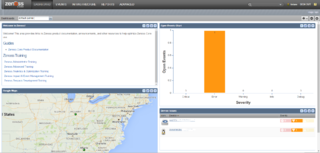Related Research Articles
In network management, fault management is the set of functions that detect, isolate, and correct malfunctions in a telecommunications network, compensate for environmental changes, and include maintaining and examining error logs, accepting and acting on error detection notifications, tracing and identifying faults, carrying out sequences of diagnostics tests, correcting faults, reporting error conditions, and localizing and tracing faults by examining and manipulating database information.
Domain Technologie Control (DTC) is a web hosting control panel aimed at providing a graphics-oriented layout for managing commercial hosting of web servers, intended for shared web hosting servers, virtual private servers (VPSes), and dedicated servers. Domain Technologie Control is free software released under the GNU LGPL v2.1 license. It is fully skinnable and translated into several languages.
The following tables compare general and technical information for many wiki software packages.
Network monitoring is the use of a system that constantly monitors a computer network for slow or failing components and that notifies the network administrator in case of outages or other trouble. Network monitoring is part of network management.

Mantis Bug Tracker is a free and open source, web-based bug tracking system. The most common use of MantisBT is to track software defects. However, MantisBT is often configured by users to serve as a more generic issue tracking system and project management tool.
Push technology or server push is a style of Internet-based communication where the request for a given transaction is initiated by the publisher or central server. It is contrasted with pull, or get, where the request for the transmission of information is initiated by the receiver or client.
Selenium is an open source umbrella project for a range of tools and libraries aimed at supporting browser automation. It provides a playback tool for authoring functional tests across most modern web browsers, without the need to learn a test scripting language. It also provides a test domain-specific language (Selenese) to write tests in a number of popular programming languages, including JavaScript (Node.js), C#, Groovy, Java, Perl, PHP, Python, Ruby and Scala. Selenium runs on Windows, Linux, and macOS. It is open-source software released under the Apache License 2.0.

The company Zenoss, Inc. was founded in 2005 and is headquartered in Austin, Texas. The company develops hybrid IT monitoring and analytics software.
An automounter is any program or software facility which automatically mounts filesystems in response to access operations by user programs. An automounter system utility, when notified of file and directory access attempts under selectively monitored subdirectory trees, dynamically and transparently makes local or remote devices accessible.
Avaya Unified Communications Management in Computer Networking is the name of a collection of GUI software programs from Avaya. It uses a service-oriented architecture (SOA) that serves as a foundation forunifying the configuration and monitoring of Avaya Unified Communications Servers and data systems.

Shinken is an open source computer system and network monitoring software application compatible with Nagios. It watches hosts and services, gathers performance data and alerts users when error conditions occur and again when the conditions clear.
Big Brother was a tool for systems and network monitoring, generally used by system administrators. The advent of the dynamic web page allowed Big Brother to be one of the first monitoring systems to use the web as its user interface. Prior to this, monitoring tools were generally console based, or required graphic terminals such as X Window to operate. Big Brother produces HTML pages containing a simple matrix of hosts and tests with red and green dots to denote system status. Big Brother was named after George Orwell's character Big Brother from his novel Nineteen Eighty-Four. E-mail from Big Brother originated from the Ministry of Truth, and users of the software were called Brothers.

Xymon, a network monitoring application using free software, operates under the GNU General Public License; its central server runs on Unix and Linux hosts.

Icinga is an open-source computer system and network monitoring application. It was originally created as a fork of the Nagios system monitoring application in 2009.
FHFS is a FTP and HTTP Web Server package, transparently based on HFS and FileZilla. FHFS is built to act as an all-in-one user-based file hosting website, good for schools, businesses, etc. whose students/employees need to easily transport files. FHFS is designed specifically for account-based storage, not easily compatible with other uses or using over-top of an original HFS setup. Early development was started in January 2011, beta builds were tested in October 2011, version 1.0 was released on 11/3/2011. FHFS was started to accelerate development on FileSplat.com, as well as showcase the capabilities of HFS macros. FHFS 2.0 was released on 10/28/2012, exactly one year after the first beta of 1.0. FHFS was loosely based on source code from www.filesplat.com at the time, and was created by the same developer. Filesplat no longer uses FHFS. FHFS is written in several different languages, including: HFS Macros, XML, XHTML, CSS, JavaScript, DOS, PHP, and C#. FHFS is recognized by the developer of HFS. FHFS 2.0.5 contains roughly 9500 somewhat-compressed lines or 412,000 characters of original code.
Checkmk is a software developed in Python and C++ for IT Infrastructure monitoring. It is used for the monitoring of servers, applications, networks, cloud infrastructures, containers, storage, databases and environment sensors.

Naemon is an open-source computer system monitoring, network monitoring and infrastructure monitoring software application. Naemon offers monitoring and alerting services for servers, switches, applications, and services. It alerts the users when things go wrong and alerts them a second time when the problem has been resolved. Naemon was created in 2014 as a fork of Nagios.

SNAMP is an open-source, cross-platform software platform for telemetry, tracing and elasticity management of distributed applications.
Buddy is a web-based and self-hosted continuous integration and delivery software for Git developers that can be used to build, test, and deploy web sites and applications with code from GitHub, Bitbucket, and GitLab. It employs Docker containers with pre-installed languages and frameworks for builds, alongside DevOps, monitoring and notification actions.
References
- ↑ first release referenced in http://www.purplepixie.org/freenats/news.php?id=91
- ↑ FreeNATS Release Download
- ↑ NetworkWorld.com Article on FreeNATS
- ↑ PC Quest Article Archived 2009-02-10 at the Wayback Machine on FreeNATS
- ↑ Master Node Documentation on FreeNATS Wiki